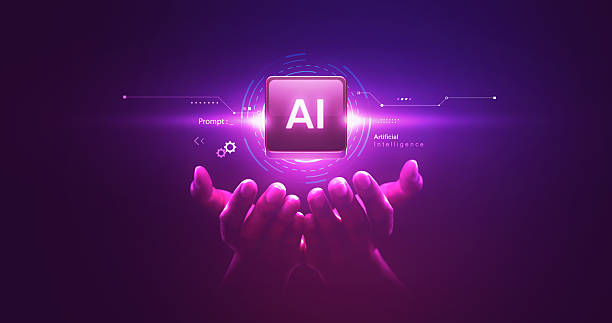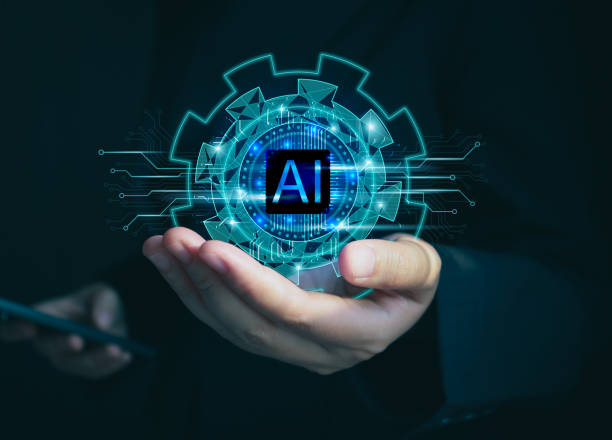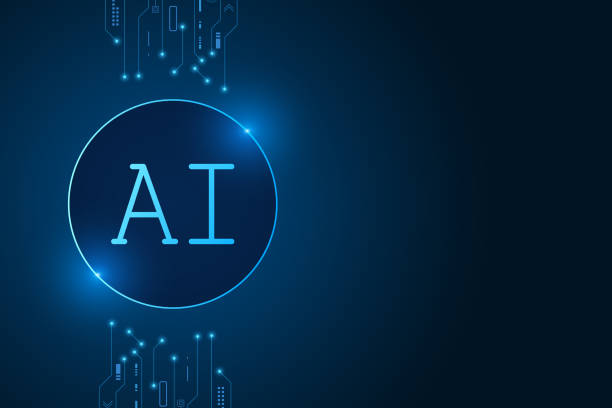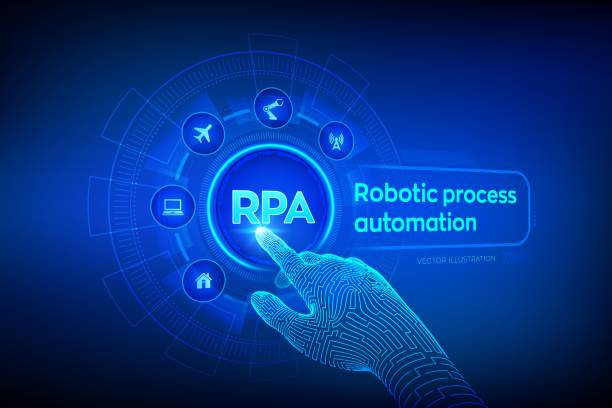What is an AI Robot and How Does it Work?

An AI robot is a software or hardware system that, using machine learning algorithms, natural language processing, and other AI techniques, is capable of performing tasks that typically require human intelligence.
These tasks can include language comprehension, decision-making, problem-solving, and learning from experiences.
Artificial intelligence allows robots to interact with their surroundings and perform various tasks.
The way an AI robot works depends on its type and application.
Generally, these robots receive data through sensors or other inputs, then process this data using AI algorithms and make decisions based on it.
Finally, the robot performs an action based on its decision.
Natural Language Processing plays an important role in the robot’s ability to understand and respond to human commands.
AI robots are used in various fields, including manufacturing, customer service, medicine, and education.
Did you know that 85% of customers check your company’s website before any interaction?
Build a corporate website worthy of your credibility with Rasaweb.
✅ Increase customer credibility and trust
✅ Attract high-quality leads
⚡ Get free website design consultation
Types of AI Robots and Their Applications

There are different types of AI robots, each designed for specific applications.
Some of the most common types of AI robots include:
- Chatbots: These robots are designed to interact with users via text or voice and can answer questions, provide information, and help with simple tasks.
- Industrial Robots: These robots are used to perform repetitive and dangerous tasks in industrial environments.
- Medical Robots: These robots are used to assist doctors in performing surgeries, diagnosing diseases, and caring for patients.
- Home Robots: These robots are used to perform various tasks at home, such as cleaning, gardening, and caring for the elderly.
AI robots are rapidly advancing and are expected to play an even more important role in our lives in the future.
AI robots, using artificial intelligence and machine learning, can perform more complex tasks and operate independently.
Advantages and Disadvantages of Using AI Robots

The use of AI robots has several advantages and disadvantages.
Some of the most important advantages include:
- Increased Productivity: Robots can perform tasks faster and more accurately than humans, leading to increased productivity.
- Cost Reduction: Using robots can reduce labor costs.
- Improved Safety: Robots can perform dangerous tasks instead of humans, leading to improved safety.
- High Accuracy: Robots can perform tasks with very high accuracy and reduce errors.
Disadvantages of using AI robots include:
- High Initial Cost: Purchasing and installing robots can be expensive.
- Need for Expertise: Expertise is required to set up and maintain robots.
- Job Loss: The use of robots can lead to job losses for some people.
The decision to use AI robots should be made by considering its advantages and disadvantages and according to the specific needs and conditions of each organization.
AI robots can help improve performance and efficiency, but the challenges associated with them should also be considered.
| Advantages | Disadvantages |
|---|---|
| Increased Productivity | High Initial Cost |
| Cost Reduction | Need for Expertise |
| Improved Safety | Job Loss |
Challenges in Developing and Implementing AI Robots

Developing and implementing AI robots comes with several challenges.
One of the most important challenges is collecting and preparing training data.
AI algorithms require a large amount of data to learn and function correctly.
Another challenge is designing AI algorithms that are capable of solving complex problems and making accurate decisions.
Machine learning and developing suitable algorithms for robots require high technical expertise and knowledge.
In addition, ethical and accountability issues related to robots are also important challenges.
It must be ensured that robots act according to ethical principles and that responsibility is accepted in case of errors.
AI robots can help improve human lives, but their ethical and social challenges must also be considered.
Finally, ensuring the security of robots and preventing their misuse is also of great importance.
Are you worried that your company’s old website is driving away new customers? Rasaweb solves this problem by designing a modern and efficient corporate website.
✅ Increases your brand credibility.
✅ Helps to attract targeted customers.
⚡ Contact Rasaweb for a free consultation!
What Will the Future of AI Robots Be?

The future of AI robots is very bright and full of potential.
It is expected that in the future, robots will play a more important role in our lives and will be used in various fields, including manufacturing, customer service, medicine, education, and transportation.
AI robots, using advancements in AI technology, will be able to perform more complex tasks and operate independently.
It is predicted that robots in the future will be able to understand human language better, interact more naturally with humans, and learn faster from experiences.
AI robots will be able to act as personal assistants, work colleagues, and even life companions.
However, the ethical and social challenges associated with the development of AI robots must also be considered, and responsible and safe use of this technology must be ensured.
Key Points in Choosing the Right AI Robot
![]()
Choosing the right AI robot for a business requires considering a number of key factors.
First of all, the specific needs of the business and the goals that are pursued by implementing the robot must be identified.
Is the goal to increase productivity, reduce costs, improve customer service, or solve a specific problem? Once the goals are identified, the types of robots available and their capabilities can be reviewed.
Another important factor is the robot’s compatibility with existing infrastructure and business information systems.
The robot should easily integrate with existing systems and exchange data effectively.
Also, the cost of purchasing, installing, setting up, and maintaining the robot should be considered.
Finally, sufficient technical support and training for using the robot should be ensured.
AI robots must be continuously updated to adapt to changes in the environment and business needs.
Case Study: Successes of AI Robots in Industry

AI robots have achieved remarkable successes in various industries.
In the manufacturing industry, robots are used to perform repetitive and dangerous tasks such as welding, painting, and packaging.
This has led to increased productivity, reduced costs, and improved safety.
AI robots in the customer service industry, chatbots are used to answer customer questions, provide information, and solve problems.
This has led to improved customer satisfaction and reduced support costs.
In the medical industry, robots are used to assist doctors in performing surgeries, diagnosing diseases, and caring for patients.
AI robots have led to improved surgical accuracy, reduced patient recovery time, and improved quality of care.
In the education industry, robots are used to provide personalized training, help students learn, and evaluate their progress.
AI robots have led to improved student learning outcomes and increased their motivation.
| Industry | Application | Result |
|---|---|---|
| Manufacturing | Welding, Painting | Increased Productivity |
| Customer Service | Answering Questions | Improved Customer Satisfaction |
| Medicine | Surgery, Disease Diagnosis | Improved Surgical Accuracy |
How to Train an AI Robot?

Training an AI robot is a complex process that requires knowledge and expertise in the field of artificial intelligence and machine learning.
In general, the process of training an AI robot includes the following steps:
- Collecting Training Data: The first step is to collect training data.
This data must be relevant to the tasks that the robot must perform. - Preparing the Data: The collected data must be prepared.
This process includes cleaning the data, converting the data to the appropriate format, and labeling the data. - Choosing a Machine Learning Algorithm: After preparing the data, a suitable machine learning algorithm must be selected.
Choosing the right algorithm depends on the type of data and the tasks that the robot must perform. - Training the Algorithm: After selecting the algorithm, the algorithm must be trained using the training data.
In this step, the algorithm learns the patterns in the data and adjusts its model accordingly. - Evaluating Performance: After training the algorithm, its performance must be evaluated.
This evaluation is done using test data that was not previously used for training. - Improving Performance: If necessary, the performance of the algorithm should be improved.
This can be done using various techniques such as adjusting algorithm parameters, collecting more training data, and using more advanced algorithms.
AI robots must be continuously trained to adapt to changes in the environment and user needs.
Did you know that customers’ first impression of your company is your website? Multiply the credibility of your business with a powerful corporate website from Rasaweb!
✅ Exclusive and eye-catching design tailored to your brand
✅ Improve user experience and increase customer acquisition
⚡ Get a free consultation!
Social and Economic Impacts of AI Robots

AI robots have broad social and economic impacts.
On the one hand, robots can help increase productivity, reduce costs, and improve the quality of life.
AI robots have led to the creation of new jobs in the development, manufacturing, maintenance, and training of robots.
On the other hand, robots can lead to job losses for some people, increased inequality, and ethical concerns.
To maximize the social and economic benefits of robots and reduce their negative effects, appropriate policies and strategies must be adopted.
These policies and strategies should include education and empowerment of the workforce, support for innovation and entrepreneurship, appropriate regulation and laws, and attention to ethical and social issues.
AI robots should be used as a tool to improve human lives and create a more just and prosperous society.
AI robots can help improve living conditions, but the social and economic issues arising from them must also be considered.
Resources and Tools for Learning AI Robotics

Various resources and tools are available for learning AI robotics.
These resources and tools include online courses, books, articles, blogs, forums, and simulation software.
Some of the most popular online AI robotics courses include those offered by Coursera, edX, and Udacity.
There are also numerous books on AI robotics that can help you learn various concepts and techniques.
Also, online blogs and forums can help you exchange information and experiences with other AI robotics enthusiasts.
Simulation software such as Gazebo and V-REP can help you test and develop virtual robots.
Using these resources and tools, you can increase your knowledge and skills in the field of AI robotics and become an expert in this field.
AI robotics is a thriving field and there are many opportunities to learn and advance.
AI robots can help improve living conditions, but the social and economic issues arising from them must also be considered.
Frequently Asked Questions
| Row | Question | Answer |
|---|---|---|
| 1 | What is an AI robot? | An AI robot is a machine capable of understanding, reasoning, learning, and problem-solving and can perform complex tasks with relative autonomy. |
| 2 | What are the most important applications of AI robots? | The main applications include industrial manufacturing, customer service (chatbots), medicine and surgery, self-driving transport, space exploration, and military affairs. |
| 3 | What is the main difference between an AI robot and a regular robot? | A regular robot only follows programmed instructions, while an AI robot can learn from data, make decisions, and adapt to new environments. |
| 4 | How do AI robots learn? | They identify patterns and improve their performance through machine learning algorithms (such as deep learning, reinforcement learning) and processing vast amounts of data. |
| 5 | Can AI robots have feelings? | Currently, AI robots do not have real feelings in the human sense. They can mimic or recognize emotions, but they do not understand and experience them. |
| 6 | What are the current limitations of AI robots? | Limitations include the need for large amounts of data, the inability to understand abstract concepts, the lack of real creativity, ethical issues, and challenges of generalizability in new environments. |
| 7 | What is the role of AI in the development of humanoid robots? | AI helps humanoid robots to walk, maintain balance, understand the surrounding environment, interact with humans, and perform complex tasks. |
| 8 | How is the future of AI robots predicted? | It is predicted that AI robots will become smarter, more autonomous, and capable of performing more complex tasks in everyday life and industry, and their interaction with humans will increase. |
| 9 | Can AI robots replace all human jobs? | It is unlikely that all human jobs will be replaced. Robots take over many repetitive and dangerous tasks, but jobs that require creativity, empathy, and ethical judgment will remain. |
| 10 | What ethical and social challenges are raised by the expansion of AI robots? | Challenges include issues related to privacy, data security, ethical decision-making by robots, impact on employment, and accountability in case of errors. |
And other services of Rasa Web advertising agency in the field of advertising
Intelligent Data Analysis: A new service to increase website visits through the use of real data.
Intelligent Custom Software: Transform website visits with intelligent data analysis.
Intelligent SEO: A quick and efficient solution to increase website visits with a focus on attractive user interface design.
Intelligent Advertising Campaign: A dedicated service to grow customer behavior analysis based on dedicated programming.
Intelligent Link Building: A professional approach to analyzing customer behavior with a focus on managing Google Ads.
And more than hundreds of other services in the field of internet advertising, advertising consulting and organizational solutions
Internet Advertising | Advertising Strategy | Advertorial
Resources
What is artificial intelligence and what are its applications?
,Applications of artificial intelligence in everyday life
,Tourism| Smart robot tourism for health and hygiene soldiers
,Invest in a chain of smart robots with market waste
? Build the future of your business in the digital world with Rasaweb Afrin! For professional company website design and launching targeted digital marketing campaigns, contact us today.
📍 Tehran, Mirdamad Street, next to the Central Bank, South Kazerun Alley, Ramin Alley, No. 6



